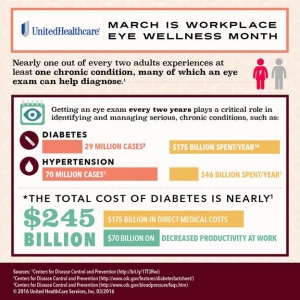
By: Dr. Linda Chous, Chief Eye Care Officer of UnitedHealthcare
Businesses looking to reduce health care costs might consider eliminating ancillary benefits such as vision coverage. But there are compelling reasons why employers should continue to offer or add these benefits, either paid for partly by the employer or as voluntary benefits with premiums paid by employees. March is Workplace Eye Wellness Month, a reminder about the importance of eye health. Here are some ways to help improve vision at the workplace:
Stop the Strain: The proliferation of smart phones has made employees more productive, but it has also had a side-effect of digital eye strain, which can result in dry eyes, eye fatigue, and headaches. To help prevent this, people should keep computer screens about 30 inches away from their eyes, rest their eyes every 15 minutes and blink frequently.
Regular Exams: Regular eye exams can help identify and manage chronic conditions, including diabetes, hypertension and some tumors. For some diseases, including multiple sclerosis and diabetes, eye care professionals can identify 15 percent of the people diagnosed with those chronic conditions, according to a UnitedHealthcare study.
Integrate Benefits: To help improve eye health and overall care, some employers are embracing an integrated approach to vision and medical benefits. These programs offer several advantages, such as automatic referrals for disease management programs and reminders about annual exams.









